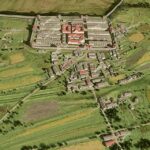In this blog, we’re exploring the Temple of Mithras at Brocolitia, located on the historic Hadrian’s Wall. Mithras is a deity whose cult, originating from Persia, was embraced and Romanised by the soldiers of the Roman Empire. This transformation led to the widespread establishment of Mithraic temples across the empire, from the Middle East to Germany, and right here on Hadrian’s Wall.

The Temple Structure and Worship Practices
The temples, or Mithraeums, were uniquely structured, typically set up to resemble a cave which symbolises the cave where Mithras is said to have slain a bull, a critical mythic act that created the world according to Mithraic belief. Upon entering the temple here at Brocolitia, you are greeted by concrete pillars marking the historical entrance where worshippers and initiates would gather. The temple’s design incorporated elements of darkness, fire, and light, central to the worship of Mithras, with a significant focus on a carved image of Mithras slaying the bull, usually surrounded by the Zodiac.
Social Structure within the Mithraeum
The Temple of Mithras operated under a tiered worship system where followers would ascend through various ranks, culminating at the highest level known as the Father. These ranks were not only spiritual but also social, influencing where individuals might sit during communal meals held on the raised beds lining the temple’s sides.

The Role of the Military and Commanding Officers
Mithraism found particular resonance among military officers rather than the rank-and-file soldiers, which is evidenced by dedications found within these temples from cavalrymen and commanding officers. The commanding officers at Brocolitia consecutively dedicated three altars to Mithras, underscoring their high rank within the cult and its significance in displaying their faith and prestige within the fort.

Modern-Day Offerings and Mithraic Legacy
Interestingly, even in the 21st century, visitors continue to leave votive offerings at this site, ranging from coins to sweets, a testament to the lasting impact and the mystical allure of Mithras that continues to captivate people.
Decline of Mithraism and Rise of Christianity
As Christianity began to spread and gain official status within the Roman Empire, the popularity of Mithraic worship declined, though it had been declining for some time. This shift led to the destruction of many Mithraic temples, including the one at Brocolitia, as Christian doctrine increasingly viewed other religious practices as idolatrous.
This journey through the Temple of Mithras at Brocolitia offers a fascinating glimpse into how a Persian deity was adopted, adapted, and eventually overshadowed by the rise of Christianity. It reflects the dynamic religious landscape of Roman Britain and the deep historical narratives embedded in the sites along Hadrian’s Wall.
I hope you’ve enjoyed this exploration into Roman religious practices and the intriguing legacy of Mithras. Keep checking back for more stories and insights from the Roman Frontier.




